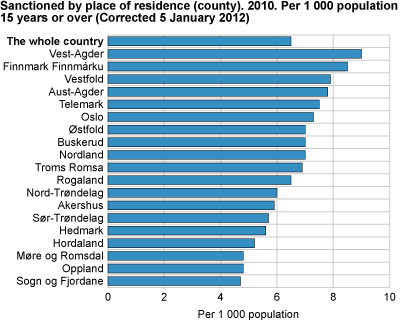Content
Published:
This is an archived release.
More sanctions in all groups of crime
In 2010, 336 000 sanctions were registered; a 7.6 per cent increase compared to the preceding year. In total, this meant that 292 000 persons were sanctioned in 2010, of which 9.6 per cent were sanctioned for one or more crimes. The amount of crimes in all main groups of crime was higher in 2010 compared to the preceding year.
In total, 302 500 sanctions were imposed for misdemeanours, which is 7 per cent higher than in 2009. The more than 33 500 sanctions in crime cases, representing the most serious offences, is as much as 12.7 per cent above the 2009 level. Despite these relatively large increases from 2009 to 2010, the number of sanctions and crimes is lower than in 2007 (see figure).
Considerably more reactions in narcotic crimes
Narcotic crimes were the principal offence in almost 14 900 sanctions. These sanctions represented slightly more than 44 per cent of all reactions in crime cases in 2010. Compared to 2009, narcotic crimes increased by nearly 16 per cent, rising to the same level as the peak year of 2001 (see figure). The number of sanctions in which crimes of profit or crimes of violence represented the principal offence increased by about 10 per cent. Sexual crimes were main offences in less than 3 per cent of all crime cases. However, with these sanctions slightly exceeding 900 in 2010, this represents a 28 per cent increase compared to 2009.
Nearly 15 800 crime sanctions were imposed by the courts. However, the prosecuting authorities resolved more crime cases than the courts. From a total of 16 400 ticket fines in such cases in 2010, more than 10 200 represented narcotic crimes as the principal crime.
Significantly more unconditional imprisonments
In contrast to a decline in a few previous years, most types of sanctions increased in 2010. The number of community sentences and conditional imprisonments increased by 11 and 8 per cent respectively from 2009 to 2010. Moreover, compared to the preceding year, 8.4 per cent more sanctions were imposed for the less serious sanctions, i.e. on the spot fines, traffic misdemeanours and violations of the Duty Act. In total, almost 254 000 on the spot fines were registered in 2010, of which nearly 202 000 represented speeding offences.
Unconditional imprisonment, however, represented the most significant increase in sanctions. Nearly 20 per cent more sentences were imposed compared to 2009. In total, for all categories of offences, more than 11 300 sanctions were registered for unconditional imprisonment, which is the same as the historically high number in 2005 (see figure). Crimes of profit represented the principal offence for 2 600 of the unconditional imprisonments, while nearly 2 400 were crimes of violence and slightly more than 1 900 were narcotic crimes. For each of these principal groups of crime there were 400 more unconditional imprisonments in 2010 compared to 2009.
Some people got more than one sanction
Twelve per cent of those sanctioned were subject to more than one sanction in 2010, and sanctions were imposed on the younger generation more frequently than older people during the year. Fourteen per cent of all sanctioned men had two or more sanctions, among sanctioned women the share was a mere 7 per cent.
Highest number sanctioned in the Agder counties
For those with a known place of residence, almost 96 per cent of those sanctioned resided in Norway in 2010. Of that, 7 per cent of the population 15 years and older are registered as sanctioned for one or more offence in 2010. By comparison, the proportion in 2009 was 6.6 per cent. However, the share of sanctioned people varies considerably among different counties. One out of ten residing in Aust-Agder were registered as sanctioned, while the corresponding proportion among those residing in the counties Sogn og Fjordane, Nordland, Troms and Møre og Romsdal constituted one out of twenty (see figure).
More than 90 per cent of all those sanctioned represent persons solely sanctioned for misdemeanours. For those sanctioned for crimes, the geographical distribution varies. Vest-Agder county represents the highest share of people sanctioned for crime in 2010, with 9 sanctioned per 1 000 population aged 15 years and over. The corresponding proportion in Finnmark county was nearly the same - i.e. 8.5 per 1 000 population. Compared to Vest-Agder, the proportion of those sanctioned for crime was close to half that in Sogn og Fjordane, Oppland and Møre og Romsdal (see figure).
Many young men
A total of 10.6 per cent of the punishable male population in Norway was registered for one offence or more in 2010. The corresponding proportion for women residing in Norway was 3.4 per cent. Most of them, particularly the women, have committed less serious offences. For instance, only 1.1 per cent of men and 0.2 per cent of women residing in Norway were registered as sanctioned for one or more offence in 2010.
Young men are clearly overrepresented in the crime statistics on sanctions, where men aged 20-22 years represent the largest proportion - at a level of 3.5 per cent (see figure). Out of all men sanctioned for crimes, 56 per cent were in the 17-30 year age interval.
Of the total number of those sanctioned for whom sex is known in 2010, 24 per cent were women, while the proportion was less than 16 per cent in crime cases. We find the largest proportion of women sanctioned for offences for profit (27 per cent), traffic offences (25 per cent) and narcotic offences (17 per cent); approximately as in 2009. On the other hand, men are overrepresented for violence and sexual offences and property damage as principal offences.
Tables
Contact
-
Sigmund Book Mohn
E-mail: sigmund.mohn@ssb.no
tel.: (+47) 94 32 77 22
-
Reid Jone Stene
E-mail: reid.jone.stene@ssb.no
tel.: (+47) 99 02 22 01







